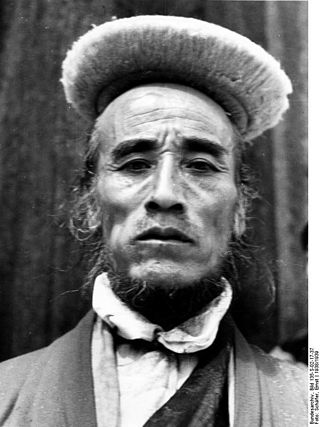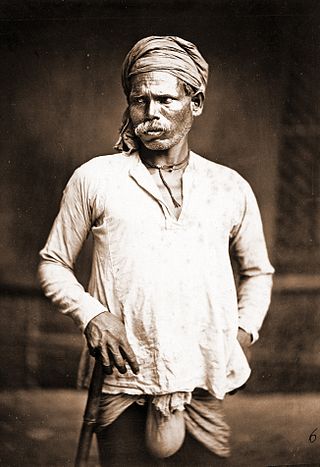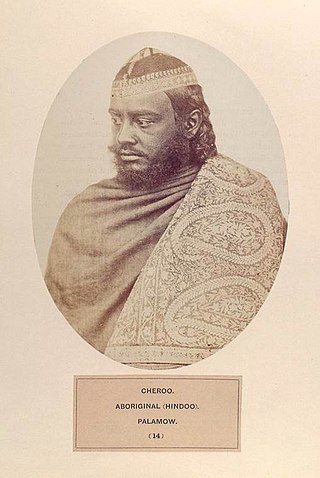Mala is a Telugu caste from the Indian states of Andhra Pradesh and Telangana. They are also present in smaller numbers in the states of Karnataka and Maharashtra. They are considered as Scheduled Caste (SC) or OBC depending on religious status by the Government of India. According to 2001 census data, Malas constituted 41.6 percent of the Scheduled Castes population in the then state of Andhra Pradesh, which also included the present state of Telangana.

Bhotiya or Bhot is an Indian and Nepali exonym lumping together various ethnic groups speaking Tibetic languages, as well as some groups speaking other Tibeto-Burman languages living in the Transhimalayan region that divides India from Tibet. The word Bhotiya comes from the classical Tibetan name for Tibet, བོད, bod. The Bhotiya speak numerous languages including Ladakhi. The Indian recognition of such language is Bhoti / Bhotia having Tibetan scripts and it lies in the Parliament of India to become one of the official languages through Eighth Schedule of the Indian Constitution.
The Other Backward Class (OBC) is a collective term used by the Government of India to classify castes that are educationally or socially backward. It is one of several official classifications of the population of India, along with general castes, Scheduled Castes and Scheduled Tribes (SCs and STs). The OBCs were found to comprise 52% of the country's population by the Mandal Commission report of 1980 and were determined to be 41% in 2006 when the National Sample Survey Organisation took place. There is substantial debate over the exact number of OBCs in India; it is generally estimated to be sizable, but many believe that it is higher than the figures quoted by either the Mandal Commission or the National Sample Survey.

The Scheduled Castes and Scheduled Tribes are officially designated groups of people and among the most disadvantaged socio-economic groups in India. The terms are recognized in the Constitution of India and the groups are designated in one or other of the categories. For much of the period of British rule in the Indian subcontinent, they were known as the Depressed Classes.

The Dom, also known as Domra, Domba, Domaka, Dombara and Dombari, are castes, or groups, scattered across India. Dom were a caste of drummer. According to Tantra scriptures, the Dom were engaged in the occupations of singing and playing music. Historically, they were considered an untouchable caste called the Dalits and their traditional occupation was the disposal and cremation of dead bodies. They are in the list of Scheduled caste for Reservation in India in the Indian states of Uttar Pradesh, Bihar, Odisha, Andhra Pradesh, Jharkhand and West Bengal.

Chamar is a Dalit community classified as a Scheduled Caste under modern India's system of affirmative action. They are found throughout the Indian subcontinent, mainly in the northern states of India and in Pakistan and Nepal.
Reservation is a system of affirmative action in India created during the British rule. It provides historically disadvantaged groups representation in education, employment, government schemes, scholarships and politics. Based on provisions in the Indian Constitution, it allows the Union Government and the States and Territories of India to set reserved quotas or seats, at particular percentage in Education Admissions, Employments, Political Bodies, Promotions, etc., for "socially and educationally backward citizens."
In India, a number of political positions and university posts are held for specific groups of the population, including Scheduled Castes and Scheduled Tribes, and women in some cases.
The demographics of Uttar Pradesh is a complex topic, which is undergoing dynamic change. Uttar Pradesh is India's most populous state, and the largest subdivision in the world. It has a population of about 199,812,341 as per the 2011 census. If it were a separate country, Uttar Pradesh would be the world's fifth most populous nation, next only to China, the rest of India, the United States of America and Indonesia. Uttar Pradesh has a population more than that of Pakistan. There is an average population density of 828 persons per km2 i.e. 2,146 per sq mi. The capital of Uttar Pradesh is Lucknow, and Prayagraj serves as the state’s judicial capital. Hindus and Muslims both consider the state as a holy place.

The Uttar Pradesh Legislative Council also known as Uttar Pradesh Vidhan Parishad is the upper house of the bicameral legislature of Uttar Pradesh, a state in India. Uttar Pradesh is one of the six states in India, where the state legislature is bicameral, comprising two houses: the Vidhan Sabha and the Vidhan Parishad. The Vidhan Parishad is a permanent house, consisting of 100 members.
The Kewat, also spelled Kevat, is a Hindu caste, found in the states of Rajasthan, Madhya Pradesh, Chhattisgarh, Odisha, Bihar and Uttar Pradesh in India. They are the traditional boatmen of northern India, and also in neighbouring country Nepal.
The Lal Begi, or Lalbegi, are a Chuhra caste found in the states of Bihar and Uttar Pradesh in India, as well as in Multan, Dera Ghazi Khan and Bahawalpur in Pakistan.

The Bhar are a caste in India.

The Chero is a caste found in the states of Bihar, Jharkhand and Uttar Pradesh in India.

The Bhuiyan or Bhuiya are an indigenous community found in the Indian states of Bihar, Jharkhand, Madhya Pradesh, Odisha, Uttar Pradesh and West Bengal. They are not only geographically disparate but also have many cultural variations and subgroups.
Chandausi is one of the 403 Legislative Assembly constituencies of Uttar Pradesh state in India.
Garhmukteshwar Assembly constituency is one of the 403 constituencies of the Uttar Pradesh Legislative Assembly, India. It is a part of the Hapur district and one of the five assembly constituencies in the Amroha Lok Sabha constituency. First election in this assembly constituency was held in 1957 after the Delimitation of Parliamentary and Assembly Constituencies Order 1961 (DPACO) was passed. After DPACO 2008 was passed, the constituency was assigned identification number 60.
Faridpur Assembly constituency is one of the 403 constituencies of the Uttar Pradesh Legislative Assembly, India. It is a part of the Bareilly district and one of the five assembly constituencies in the Aonla Lok Sabha constituency. First election in this assembly constituency was held in 1957 after the "DPACO (1956)" was passed in 1956. After the "Delimitation of Parliamentary and Assembly Constituencies Order" was passed in 2008, the constituency was assigned identification number 122 and is reserved for candidates from the Scheduled caste community.
Kori/koli is an Indian caste, who were traditionally weavers and fishermen. They are descendants of Ishvakuwanshi Raja Mandhata ji and Saint Kabir Das Ji Maharaj. Other names for this caste include Kamal, Kamalvansi and Shankhawar, Kabirpanthi and Julaha







